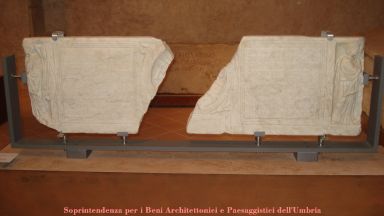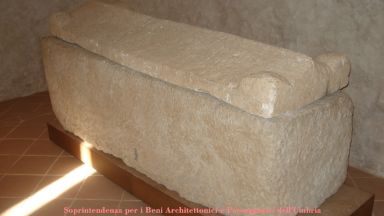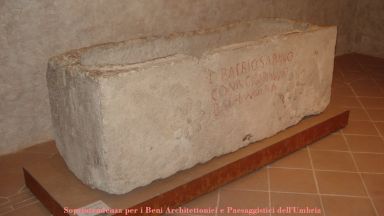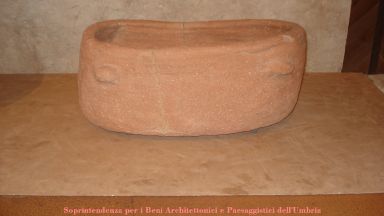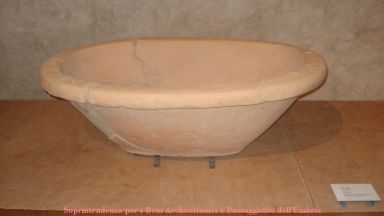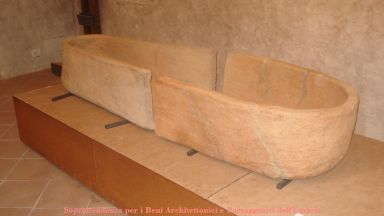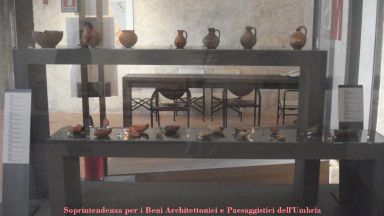Room 1
I/1 front of sarcophagus of Pontia
marble, in two not matching fragments, second half IV century
cm 45 x 161 x 10
from the oratory of S. Giovenale in Macerino (Acquasparta, TR)
The front of the sarcophagus is divided into three zones and concluded by two separate and crowned images, the left one leans out from a curtain.
In the centre, strongly incom- plete, a christogram with side apocalyptic letters, on the bottom left part one hand holds the book.
The two side zones host two “tabule ansate” (winged boars) with Latin inscriptions in distich: on the left Pontia sidereis aspirans vultibus olim / hic iacet aetherio semine lapsa fuit / omnes honos omnes cesit tibi gratia formae / mens quoque cum vultus digna nitore fuit / tradita virgo toris decimum non pertulit annum / coniugii infelix unica prole perit / quantus amor mentis probitas quam grata marito / quam casti mores quantus et ipse pudor / nil tibi quod foedum vitium nec moribus ullum / dum satis obsequeris famula dicta viri.
On the right denique te memet fatis odioque gravatum / dum sequeris vidit Corsica cum lacrimis / tu Treviros pergens cursu subvecta rotarum / coniugis heu cultrix, dura satis pateris / te pater infestus genero cum tollere vellet / temtasti laqueum si faceret genitor / cedite iam veterum laudes omnesque maritae / tempora nulla dabunt talia quae faciat / vir tuus ingenti gemitu fletuque rigatus / hos feci versus pauca tamen memorans.
Along the frame, on the bottom left part: hic legit auctores mu [- - -].
The Christian matron of Ponzia was buried, dead because a carriage ran over her along the via Flaminia, near Carsulæ, during a trip towards Treviri with her husband.
I/2 sarcophagus
limestone, V – VI century, end - start
cm 71 x 64 x 193
Spoleto, funerary area adjacent to the church of the Apostles.
Case sarcophagus with double sloping cover,with angular acroterions.
I/3 sarcophagus of Lucio bæbio sabino
limestone, V – VI century, end - start
cm 70 x 197 x 67
Spoleto, church of S. Sabino
Sarcophagus decorated on the front by two eight-petal rosettes with central bud, placed at the sides of an inscription. Sepulchral inscription in Latin, written in capital letters: L. baebio sabino / coniux carissimo / baebia mustia.
I/4 sarcofago del Buon Pastore
(sarcophagus of the Good Shepherd)
marble, V century
cm 47 x 116 x 54
Sarcophagus with five decorative partitions on the front: at the extremities two representa- tions of the Good Shepherd, in intermediate position two strigil fields and in the centre the image of a person in prayer framed by a curtain.
I/5 sarcophagus
moulded earthenware, VI century
cm 37 x 82 x 47
Spoleto, funerary area adjacent to the church of S. Pietro.
I/6 sarcophagus
moulded earthenware, VI century
cm 40 x 120 x 76
Spoleto, funerary area adjacent to the church of S. Pietro.
I/7 sarcophagus
moulded earthenware, VI century
cm 33,5 x 55 x 120; cm 35 x 57 x 95
Spoleto, funerary area adjacent to the church of S. Pietro.
In the Spoletian area between the IV and VI centuries sarcophagus were made in marble, limestone sand earthenware to satisfy the dif- ferent social and economical categories. Particular manufacture is foreseen for locally produced earthenware sarcophagus made with moulds in two roughly matching parts; they are also found in other funerary areas, for example near the church of S. Gregorio Maggiore and the monastery of S. Ponziano.
I/8 oil lamp
moulded earthenware
V – VI century, end - start
cm 12,2 x 8,5 x 3,6
Spoleto, via Cecili, excavation Sordini
I/9 oil lamp
moulded earthenware
V – VI century, end - start
cm 11 x 8,5 x 3
I/10 oil lamp
moulded earthenware
V – VI century, end - start
cm 7 x 4,2 x 1
Spoleto, via Cecili, excavation Sordini
I/11 oil lamp
moulded earthenware
V – VI century, end - start
cm 7,3 x 3,2 x 1
Spoleto, via Cecili, excavation Sordini
I/12 oil lamp
moulded earthenware
V – VI century, end - start
cm 12,2 x 6,8 x 1,9
Spoleto, via Cecili, excavation Sordini
I/13 oil lamp
moulded earthenware
V – VI century, end - start
cm 10,5 x 7,2 x 2,8
Spoleto, via Cecili, excavation Sordini
I/14 oil lamp
moulded earthenware
V – VI century, end - start
cm 9,8 x 7 x 3,1
Spoleto, via Cecili, excavation Sordini
I/15 oil lamp
moulded earthenware
V – VI century, end - start
cm 4 x 11 x 7
Spoleto, via Cecili, excavation Sordini
I/16 oil lamp
moulded earthenware
V – VI century, end - start
cm 3,2 x 10,4 x 5
Spoleto, via Cecili, excavation Sordini.
I/17 oil lamp
moulded earthenware
V – VI century, end - start
cm 9,2 x 11,2 x 7
Spoleto, via Cecili, excavation Sordini
I/18 oil lamp
moulded earthenware
V – VI century, end - start
cm 2,7 x 5,5 x 7
Spoleto, via Cecili, excavation Sordini
I/19 oil lamp
moulded earthenware
V – VI century, end - start
cm 8,9 x 6,3 x 3
Poggiodomo (PG), church of S. Salvatore
I/20 oil lamp
moulded earthenware, VIII century
cm 3,5 x 6,5 x 6
Spoleto, via Cecili, excavation Sordini
I/21 oil lamp
moulded earthenware, VIII century
cm 4,4 x 10,2 x 7,5
Spoleto, via Cecili, excavation Sordini
I/22 oil lamp
moulded earthenware, VIII century
cm 4 x 10 x 7
Spoleto, via Cecili, excavation Sordini.
The earthenware oil-lamps that were mostly found in funerary contexts represent a sampling of the Late Antiquity and Early Middle Age productions. Those made with “Terra Sigillata Chiara” (Clear sealed earth) (n. 8-12) come from Africa; they are often decorated with Christian religious symbols like christograms and monogram crosses even gemmed as well as animals like the peacock and the lamb.
Some of the light coloured oil-lamps are an imitation of the most expensive imports from North Africa (n.13-21), normally considered as local production, with vegetal motif decorations especially the multi-petal rosette.
The three “flat” oil lamps are dated back on the VIII century (n. 22-24), decorated with large relief points and with glass coating, probably influenced by an Early Middle Age relationship of the Spoletian area of via Cecili, not for funerary use.
I/23 small jug
moulded earthenware
V – VI century, end - start
h. cm 11; diam. max cm 6
from excavations at Castel S. Felice – Sant’Anatolia di Narco (PG)
I/24 small jug
moulded earthenware
V – VI century, end - start
h. cm 13, diam. max. cm 11,2
from the funeral area of the church of St. Pietro in Spoleto
I/25 small jug
moulded earthenware
V – VI century, end - start
h. cm 14; diam. max. cm 10,8
from the funeral area of the church of St. Pietro in Spoleto
I/26 small jug
moulded earthenware
V – VI century, end - start
h. cm 17; diam. max cm 13,8
I/27 small jug
moulded earthenware
V – VI century, end - start
h. cm 15; diam. max cm 10,4
Poggiodomo (PG), church of S. Salvatore
I/28 small jug
moulded earthenware
V – VI century, end - start
h. cm 11,3; diam. max cm 12,3
I/29 olla
moulded earthenware
V – VI century, end - start
h. cm 10,9; diam. max 20,5
Poggiodomo (PG), church of S. Salvatore
The ceramic containers displayed include small jugs and kitchen recipients, all produced in late antiquity and still in existence at the beginning of the High Middle Ages.
They originate from various sites in the Spoleto area, in some cases from tomb settings, underlining the widespread practice of grave goods, which in late antiquity was often limited, as far as ceramic materials were concerned, to small drinking vessels. The variety of clay mixtures show the wealth of production present in the Spoleto territory while the standardisation of form, almost exclusively single handled jugs with a globular body, reflects the late antique tendency to formal uniformity in this type of ceramic, thought to be specifically for funerary products.




